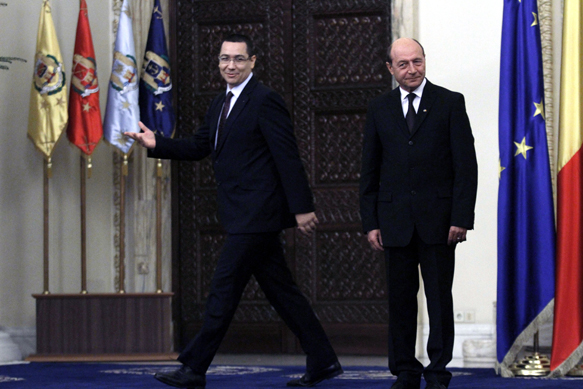
Romanian Gas Pipeline Might Free Moldova from Gazprom’s Monopoly
Publication: Eurasia Daily Monitor Volume: 10 Issue: 133
By:

Visiting the Republic of Moldova on July 17, Romanian President Traian Basescu announced the imminent start of the construction of a natural gas pipeline to connect Romania with Moldova. The work is planned to start on August 27 (Moldpres, July 17, 18). Its modest size notwithstanding, this project has active and latent implications for Romania’s and Moldova’s energy security, for the Russian gas trade and transit in the wider region, for any future resolution of the Transnistria conflict, and for the successful implementation of energy sector reforms in the European Energy Community’s framework.
The pipeline from Romania, with its planned capacity of 1.5 billion cubic meters (bcm) per year, and underbidding Gazprom’s price, can free Moldova (minus Transnistria) at one stroke from Gazprom’s supply monopoly. If built as planned, the pipeline can also remove an instrument of political blackmail from Moscow’s hands.
In total, Moldova consumes on average some 3 to 3.5 bcm of gas per year. However, the territory under Chisinau’s control (some 80 percent of Moldova’s area and population) consumes only about 1 bcm per year (in 2012, an all-time low of 0.9 bcm). Transnistria habitually uses at least two thirds of Gazprom’s annual deliveries to Moldova as a whole. The pipeline runs to Chisinau through Tiraspol. Hypothetically, Tiraspol can physically disrupt the supplies without Moscow taking the blame for such an action.
Transnistria owes a staggering debt approaching $4 billion (including penalties) to Gazprom for past deliveries of gas (the Russian government put the debt at $3.5 billion in 2012, see EDM, September 14, 2012). That debt keeps growing as the Russian government and Gazprom do not attempt to collect either old arrears or current payments. For its part, Chisinau-controlled Moldova owes some $600 million in old debts mostly from the 1990s, and has been paying the bills to Gazprom regularly for the last ten years or so.
The Russian government takes the position that Moldova (Chisinau) should assume responsibility for Transnistria’s gas debts, in the event of Moldova’s reunification. Russia can use this conditionality indefinitely to obstruct a political settlement of the Transnistria conflict or to skew its terms. Instead of either collecting or forgiving Transnistria’s debts, Moscow deliberately allows them to grow heavier as an instrument of pressure on Chisinau. This is also intended to dissuade the European Union from integrating Moldova in the future. For its part, Chisinau seeks separation of Transnistria’s gas debts and gas bills from those of the rest of Moldova.
The pipeline from Romania can help achieve that separation of Chisinau’s gas accounts from Tiraspol’s. The pipeline’s capacity, if properly used, would allow Moldova to renounce Gazprom’s supplies entirely, upon the expiry of the binding contract; or to reduce the volume of Gazprom’s supplies and bargain down their price.
In that case, the pipeline from Romania could also help open a discussion on the status of the Russian-controlled MoldovaGaz company. MoldovaGaz owns and operates the transit and distribution pipelines in the country. The transit pipeline runs from Moldova via Ukraine and Romania, onward to Bulgaria and Greece (with a West-Balkan branchoff) and Turkey (Istanbul and other urban agglomerations in Turkey’s west). The MoldovaGaz transit pipeline carries more than 20 bcm of Russian gas annually en route to those Balkan countries.
Gazprom holds 50 percent ownership of MoldovaGaz; Tiraspol owns a further 13.5 percent, handed over to Gazprom in trust management; the Moldovan government holds 35 percent; and unnamed small shareholders hold 1.5 percent (Infotag, May 31). Moldova is a member of the European Energy Community, a signatory to the EEC’s Treaty since 2010 and to the treaty protocol in 2011. As such, Moldova aims to implement the reform of its energy sector from 2015 onward. This would entail Gazprom’s loss of control (at least of direct control) over the pipelines.
Last year, the Russian government asked Moldova to withdraw from the European Energy Community Treaty, and desist from implementing the energy sector reforms, in return for a 30 percent discount on the price of Russian gas and a postponement of collecting Chisinau’s debts. Moldova’s supply contract with Gazprom expired at the end of 2011. It is being prolonged de facto, pending negotiation of a new contract. Moldova has been paying nearly $400 per one thousand meters during 2012; and it pays $387 at present and through the end of 2013 (RFE/RL, June 11).
Such a price is deemed a heavy burden on Europe’s most impoverished country. The tempting discount would have lowered the price to some $260 – $270, in return for Moldova reneging on European commitments. The pipeline from Romania, when it materializes, would enable Chisinau to overcome such dilemmas and reform its energy sector.
This pipeline project is a Romanian initiative, dating back to 2009 if not earlier. It was delayed, however, by Romania’s inability to provide financing and gas for the project. Financing has now become available from the European Union. The 43-kilometer pipeline will cross the border from Iasi in Romania to Ungheni in the Republic of Moldova. The Iasi-Ungheni pipeline is due for completion apparently by December 2013, at a cost of at least €20 million (approximately $26 million) (Agerpres, July 17).
Moldova’s Economics Minister, Valeriu Lazar, suggests that the Gazprom-controlled MoldovaGaz should be the market operator for gas received from the Iasi-Ungheni pipeline. This role would presumably induce Gazprom to accept the Iasi-Ungheni project (RFE/RL,June 11). The argument is questionable. MoldovaGaz must be reformed first.
Romania consumes some 14 bcm of gas annually, including some 11 bcm from internal production. The remainder is imported from Gazprom, via Gazprom-appointed intermediary companies, at prices far above that of internal production. Romania used to be a large-scale producer of methane gas; the extraction peaked at more than 30 bcm annually during Communist times. But the known reserves are running low, and the governments of the last 20 years have carefully reduced the production rate. Consequently, Romania has declined to supply Moldova with Romanian gas during all these years. This helps explain why Bucharest seemed unwilling or unable to spend a mere €20 million for building the Iasi-Ungheni pipeline.
The source of gas for the Iasi-Ungheni pipeline seems far from certain at this point. Romania had counted heavily on the Nabbucco project, but this is now lost (see EDM, June 25, 27, 28). A joint venture of ExxonMobil and OMV in Romania has recently struck gas offshore in the Black Sea. Estimated at between 45 and 85 bcm, that first find is modest, and potentially eyed by multiple solvent claimants. Meanwhile, Chevron plans shale gas exploration at several Romanian locations onshore. According to Basescu in Chisinau, offshore Black Sea gas could come on stream commercially at some point between 2015 and 2018 (volumes unspecified, and shale gas an unknown thus far).
Thus, a gap of several years may ensue between the planned completion of the Iasi-Ungheni pipeline (December 2013) and a commercial flow of gas from newly discovered Romanian fields (2015 to 2018). Therefore, Bucharest ought to seriously consider supplying Moldova with gas from Romania’s internal production (see above). Adding 1 bcm per year to supply Moldova from 2014 onward would not unduly accelerate the depletion rate of Romania’s existing deposits until the new ones come on stream. The Iasi-Ungheni pipeline would turn into an embarrassment if it becomes operational in 2014 without gas, or if it is used at a fraction of its capacity. Filling this pipeline with at least 1 bcm annually, before new Romanian fields come on stream, should realistically be within Romania’s possibilities.




